
The PCC is a tram design that was first built in the United States in the 1930s. The design proved successful domestically, and after World War II it was licensed for use elsewhere in the world where PCC based cars were made. The PCC car has proved to be a long-lasting icon of streetcar design, and many remain in service around the world.

The F Market & Wharves line is one of several light rail lines in San Francisco, California. Unlike most other lines in the system, the F line runs as a heritage streetcar service, almost exclusively using historic equipment both from San Francisco's retired fleet as well as from cities around the world. While the F line is operated by the San Francisco Municipal Railway (Muni), its operation is supported by Market Street Railway, a nonprofit organization of streetcar enthusiasts which raises funds and helps to restore vintage streetcars.
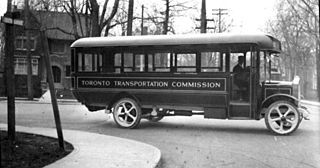
Toronto Transportation Commission (TTC) was the public transit operator in Toronto, Ontario, Canada, beginning in 1921. It operated buses, streetcars and the island ferries. The system was renamed the Toronto Transit Commission (TTC) in 1954.

The San Diego Electric Railway (SDERy) was a mass transit system in Southern California, United States, using 600 volt DC streetcars and buses.
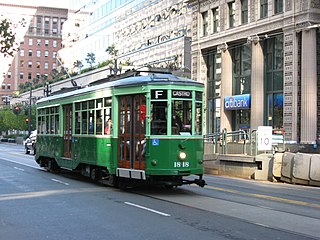
The Peter Witt streetcar was introduced by Cleveland Railway commissioner Peter Witt (1869–1948) who led the transit agency from 1911–1915 and designed a model of streetcar known by his name that was used in many North American cities, most notably in Toronto and Cleveland.

Streetcars in Washington, D.C. transported people across the city and region from 1862 until 1962.

The Presidents' Conference Committee Car was a streetcar used by the Toronto Transportation Commission and the Toronto Transit Commission. The PCC streetcar was designed by the Presidents' Conference Committee, a group of transit operators in the United States and Canada.

The M-Line Trolley is a heritage streetcar line in the Uptown neighborhood of Dallas, Texas. The trolley line, which has been in service since 1989, is notable for its use of restored historic streetcar vehicles, as opposed to modern replicas.

Streetcars were part of the public transit service in Kenosha, Wisconsin in the first third of the 20th century, and returned to this role in the year 2000.

Johnstown Traction Company (JTC) was a public transit system in Johnstown, Pennsylvania, United States. For most of its existence it was primarily a street-railway system, but in later years also operated rubber-tired vehicles. JTC operated trolley (tram) service in Johnstown from February 23, 1910 to June 11, 1960. Johnstown was one of the last small cities to abandon trolley service in the United States. It was also the smallest city to acquire a fleet of PCC cars and acquired trackless trolleys at a late date compared to larger transit properties. Many of the 1920s-era cars went directly to museums; however, none of the 17 PCC streetcars were saved. Efforts to sell the 16 then-surviving PCC cars intact were unsuccessful, and in 1962 they were scrapped, but many of their components were salvaged and sold to the Brussels, Belgium tram system, reused in the last series of single PCC trams (7156–7171), which ran from 1970 until February 2010.

Cincinnati Street Railway (CSR) was the public transit operator in Cincinnati, Ohio, from 1859 to 1952. The company ceased streetcar operations and was renamed Cincinnati Transit Company.

The Louisville Railway Company (LRC) was a streetcar and interurban rail operator in Louisville, Kentucky. It began under the name Louisville City Railway in 1859 as a horsecar operator and slowly acquired other rival companies. It was renamed in 1880 following the merger of all Mule operations as the Louisville Railway Company. All tracks were 5 ft gauge.

Streetcars or trolley(car)s were once the chief mode of public transit in hundreds of North American cities and towns. Most of the original urban streetcar systems were either dismantled in the mid-20th century or converted to other modes of operation, such as light rail. Today, only Toronto still operates a streetcar network essentially unchanged in layout and mode of operation.

The Third Avenue Railway System (TARS), founded 1852, was a streetcar system serving the New York City boroughs of Manhattan and the Bronx along with lower Westchester County. For a brief period of time, TARS also operated the Steinway Lines in Long Island City.
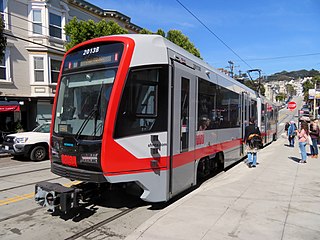
With five different modes of transport, the San Francisco Municipal Railway runs one of the most diverse fleets of vehicles in the United States. Roughly 550 diesel-electric hybrid buses, 300 electric trolleybuses, 250 modern light rail vehicles, 50 historic streetcars and 40 cable cars see active duty.
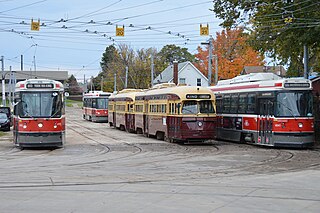
In 1921, the Toronto Transportation Commission (TTC) was created to integrate and operate the Toronto streetcar system. It inherited the infrastructure of two separate streetcar operators: the Toronto Railway Company (TRC) and Toronto Civic Railways (TCR). The TTC immediately embarked on a program to connect the TRC and TCR lines into one network. The TTC had to rebuild most of the track to provide a wider devilstrip so that the wider Peter Witt streetcars it was ordering could pass without sideswiping. Between 1938 and 1945, it placed five orders for air-electric PCC streetcars to replace the old, wooden streetcars of the TRC, and to address rising ridership. Between 1947 and 1951, the TTC placed three orders for all-electric PCC cars, with one order equipped with couplers for multiple-unit operation. Between 1950 and 1957, the TTC purchased PCCs from four American cities. By 1957, the TTC had more PCCs than any other city in North America. After the opening of the Bloor–Danforth subway in 1966, the TTC considered terminating all streetcar service in Toronto. However, in 1972, a citizens group led by Jane Jacobs and Steve Munro called "Streetcars for Toronto" persuaded the City to retain streetcar operation. This led to the development of the Canadian Light Rail Vehicle (CLRV) and its longer, articulated cousin, the Articulated Light Rail Vehicle (ALRV), to replace the aging PCC fleet. The Accessibility for Ontarians with Disabilities Act, 2005 (AODA) mandated that the next generation of streetcars be wheelchair-accessible. Thus, to replace the CLRVs and ALRVs, Bombardier adapted its low-floor Flexity Outlook model for the TTC to navigate the Toronto streetcar system's tight curves and single-point switches, characteristics set in 1921 to accommodate Peter Witt streetcars.

The 4000-series PCC was a streetcar used by the Port Authority of Allegheny County. The PCC streetcar was designed by the Presidents' Conference Committee, a group of transit operators in the United States and Canada. The 4000's were a series of cars completely rebuilt from cars built in 1949 by the St. Louis Car Company for Port Authority's predecessor, Pittsburgh Railways.

The Silver Line is a 2.7-mile (4.3 km) heritage streetcar line operated by the San Diego Trolley, an operating division of the San Diego Metropolitan Transit System. It currently operates the "downtown loop"; a circle of tracks around Downtown San Diego, and is operated using renovated historic vehicles. The line is one of four lines in the Trolley system, sharing tracks of the other lines; the other three lines are the Blue, Orange, and Green lines.
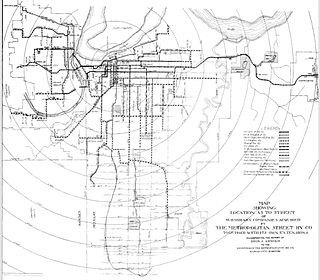
Streetcars in Kansas City were the primary public transit mode during the late 19th and early 20th centuries, like most North American cities. Kansas City, Missouri once had one of the most extensive streetcar systems in North America, but the last of its 25 streetcar routes was shut down in 1957. Kansas City joined all but five North American metropolises – Toronto, Boston, Philadelphia, San Francisco, and New Orleans – in replacing all their streetcar networks with buses. Three other cities, Newark, Pittsburgh, and Cleveland, operated rail lines more akin to modern light rail that remain operating.
Beginning operation in 1861, the Yonge streetcar line was the first streetcar line in Toronto and the first in Canada. It started off as a horsecar line and closed in 1954 operating two-unit trains of Peter Witt motors pulling a trailer. Under the Toronto Transportation Commission, the Yonge line was the busiest and most congested streetcar line in the city leading to its replacement in 1954 by the Yonge Subway line, also Toronto's first and the first in Canada.



















